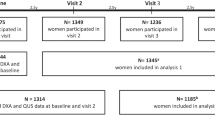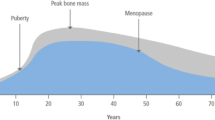Abstract
Summary
This study sought to determine the association between calcaneal quantitative ultrasound (QUS) and fracture risk in individuals without osteoporosis according to the World Health Organization criteria (i.e., BMD T-score > −2.5). We found that calcaneal QUS is an independent predictor of fracture risk in women with non-osteoporotic bone mineral density (BMD).
Introduction
More than 50 % of women and 70 % of men who sustain a fragility fracture have BMD above the osteoporotic threshold (T-score > −2.5). Calcaneal QUS is associated with fracture risk. This study aimed to test the hypothesis that low calcaneal QUS is associated with increased fracture risk in individuals with non-osteoporotic BMD.
Methods
We included 312 women and 390 men aged 62–90 years with BMD T-score > −2.5 at femoral neck. QUS was measured in broadband ultrasound attenuation (BUA) at the calcaneus using a CUBA sonometer. BMD was measured at the femoral neck (FNBMD) by dual energy X-ray absorptiometry using GE Lunar DPX-L densitometer. The incidences of any fragility fracture were ascertained by X-ray reports during the follow-up period from 1994 to 2011.
Results
Of the 702 participants, 26 % of women (n = 80/312) and 14 % of men (n = 53/390) experienced at least one fragility fracture during the follow-up period. In women, after adjusting for covariates, increased risk of any fracture was significantly associated with decreased BUA (HR = 1.50; 95 % CI, 1.13–1.99). Compared with that of FNBMD, the models with BUA, in women, had greater AUC (0.71, 0.85, 0.71 for any, hip and vertebral fracture, respectively), and yielded a net reclassification improvement of 16.4 % (P = 0.009) when combined with FNBMD. In men, BUA was not significantly associated with fracture risk before and after adjustment.
Conclusion
These results suggest that calcaneal BUA is an independent predictor of fracture risk in women with non-osteoporotic BMD.

Similar content being viewed by others
References
Nguyen ND, Ahlborg HG, Center JR, Eisman JA, Nguyen TV (2007) Residual lifetime risk of fractures in women and men. J Bone Miner Res 22:781–788
Center JR, Nguyen TV, Schneider D, Sambrook PN, Eisman JA (1999) Mortality after all major types of osteoporotic fracture in men and women: an observational study. Lancet 353:878–882
World Health Organization (1994) Assessment of fracture risk and its application to screening for postmenopausal osteoporosis. WHO Technical Report Series 843 Geneve
Nguyen ND, Eisman JA, Center JR, Nguyen TV (2007) Risk factors for fracture in nonosteoporotic men and women. J Clin Endocrinol Metab 92:955–962
Nguyen TV, Center JR, Sambrook P, Eisman JA (2001) Risk factors for proximal humerus, forearm, and wrist fractures in elderly men and women: the Dubbo Osteoporosis Study. Am J Epidemiol 153:587–595
Nguyen TV, Eisman JA, Kelly PJ, Sambrook P (1996) Risk factors for osteoporotic fractures in elderly men. Am J Epidemiol 144:255–263
Njeh CF, Hodgskinson R, Currey JD, Langton CM (1996) Orthogonal relationship between ultrasound velocity and material properties of bovine cancelleous bone. Med Eng Phys 18:373–381
Cortet B, Boutry N, Dubios P, Legroux-Gerot I, Cotton A, Marchandise X (2004) Does quantitative ultrasound of bone reflect more bone density than bone microarchitecture. Calcif Tissue Int 74:60–67
Gluer CC, Wu CY, Jergas M, Goldstgein SA, Genant HK (1994) Three quantitative parameters reflect bone structure. Calcif Tissue Int 55:46–52
Bauer DC, Gluer CC, Genant HK, Stone K (1995) Quantitative ultrasound and vertebral fracture in postmenopausal women. J Bone Miner Res 10:353–357
Diez-Perez A, Gonzalez-Macias J, Marin F, Abizanda M, Alvarez R, Gimeno A, Pegenaute E, Vila J (2007) Prediction of absolute risk of non-spinal fractures using clinical risk factors and heel quantitative ultrasound. Osteoporos Int 18:629–639
Mautalen C, Vega E, Gonzalez D, Carrilero P, Otano A, Silberman F (1995) Ultrasound and dual X-ray absorptiometry densitometry in women with hip fracture. Calcif Tissue Int 57:165–168
Sakata S, Skushida K, Yamazaki K, Inoue T (1997) Ultrasound bone densitometry of os calcis in elderly Japanese women with hip fracture. Calcif Tissue Int 60:2–7
Gluer CC (1997) Quantitative ultrasound techniques for the assessment of osteoporosis: expert agreement on current status. J Bone Miner Res 12:1280–1288
Simons LA, McCallum J, Simons J, Powell I, Ruys J, Heller R, Lerba C (1990) The Dubbo study: an Australian prospective community study of the health of elderly. Aust N Z J Med 20:783–789
Zochling J, Nguyen TV, March LM, Sambrook PN (2004) Quantitative ultrasound measurements of bone: measurement error, discordance, and their effects on longitudinal studies. Osteoporos Int 15:619–624
Nguyen TV, Sambrook P, Eisman JA (1997) Sources of variability in bone mineral density measurements: implications for study design and analysis of bone loss. J Bone Miner Res 12:124–135
Jones G, Nguyen TV, Sambrook P, Kelly PJ, Gilbert C, Eisman JA (1994) Symptomatic fracture incidence in elderly men and women: the Dubbo Osteoporosis Epidemiology study (DOES). Osteoporos Int 4:277–282
Pencina M, D’Agostino RB Sr, D’Agostino RB Jr, Vasan RS (2008) Evaluating the added predictive ability of a new marker: from area under the ROC curve to reclassification and beyond. Stat Med 27:157–172
R Development Core Team (2006) A language and environment for statistical computing. R Foundation for Statistical Computing, Vienna, Austria. <http://wwwRprojectorg>
Robbins JA, Schott AM, Garnero P, Delmas PD, Hans D, Meunier PJ (2005) Risk factors for hip fracture in women with high BMD: EPIDOS study. Osteoporos Int 16:149–154
Marin F, Gonzalez-Macias J, Diez-Perez A, Palma S, Delgado-Rodriguez M (2006) Relationship between bone quantitative ultrasound and fractures: a meta-analysis. J Bone Miner Res 21:1126–1135
Moayyeri A, Kaptoge S, Dalzell N, Luben RN, Wareham NJ, Bingham S, Reeve J, Khaw KT (2009) The effect of including quantitative heel ultrasound in models for estimation of 10-year absolute risk of fracture. Bone 45:180–184
Trebacz H, Natali A (1999) Ultrasound velocity and attenuation in cancellous bone samples from lumbar vertebrae and calcaneus. Osteoporos Int 9:99–105
Khaw KT, Jonathan R, Luben R, Bingham S, Welch A, Wareham N, Oakes S, Day N (2004) Prediction of total and hip fracture risk in men and women by quantitative ultrasound of the calcaneus: EPIC-Norfolk prospective population study. Lancet 363:197–202
Langton CM, Njeh CF (eds) (2004) The physical measurement of bone. Insitute of Physics, Bristol
van den Bergh JP, van Lenthe GH, Hermus AR, Corstens FH, Smals AG, Huiskes R (2000) Speed of sound reflects Young’s modulus as assessed by microstructural finite element analysis. Bone 26:519–524
Haiat G, Padilla F, Svrcekova M, Chevalier Y, Pahr D, Peyrin F, Laugier P, Zysset P (2009) Relationship between ultrasonic parameters and apparent trabecular bone elastic modulus: a numerical approach. J Biochem 18:2033–2039
Duquette J, Lin J, Hoffman A, Houde J, Ahmadi S, Baran D (1997) Correlations among bone mineral density, broadband ultrasound attenuation, mechanical indentation testing, and bone orientation in bovine femoral neck samples. Calcif Tissue Int 60:181–186
Delmas PD (2000) Do we need to change the WHO definition of osteoporosis? Osteoporos Int 11:189–191
Kanis JA, Gluer CC (2000) An update on the diagnosis and assessment of osteoporosis with densitometry. Osteoporos Int 11:192–202
Gielen E, Vanderschueren D, Callewaert F, Boonen S (2011) Osteoporosis in men. Best Pract Res Clin Endocrinol Metab 25:321–335
Acknowledgments
We gratefully acknowledge the assistance of Sr Janet Watters, Donna Reeves, and Shaye Field for the interview, data collection, and measurement of bone mineral density. We also appreciate the invaluable help of the staff of Dubbo Base Hospital. We thank Mr. J. McBride, Dania Mang, and the IT group of the Garvan Institute of Medical Research for the management of the database. The study was partly supported by the Australia National Health and Medical Research Council. N.D.N. is supported by a fellowship from the AMBeR (Australian Medical Bioinformatics Resource). T.V.N. is supported by a senior research fellowship from the Australian National Health and Medical Research Council.
Conflicts of interest
Professor J.A. Eisman has served as consultant on the Scientific Advisory Board for Amgen, Eli Lilly, Merck Sharp & Dohme, Novartis, Sanofi-Aventis, Servier, and deCode. He was the editor-in-chief for the Journal of Bone and Mineral Research from 2003 to 2007 and was a committee member of Department of Health and Aging, Australian Government and Royal Australasian College of General Practitioners. Dr. Jacqueling R. Center has given educational talks for Eli Lilly, Merck Sharp and Dohme, and Sanofi-Aventis. Professor T.V. Nguyen has received honorarium for consulting and speaking in symposia sponsored by MSD, Roche, Servier, Sanofi-Aventis, and Novartis. Other authors have no conflicts of interest.
Author information
Authors and Affiliations
Corresponding author
Rights and permissions
About this article
Cite this article
Chan, M.Y., Nguyen, N.D., Center, J.R. et al. Quantitative ultrasound and fracture risk prediction in non-osteoporotic men and women as defined by WHO criteria. Osteoporos Int 24, 1015–1022 (2013). https://doi.org/10.1007/s00198-012-2001-2
Received:
Accepted:
Published:
Issue Date:
DOI: https://doi.org/10.1007/s00198-012-2001-2




